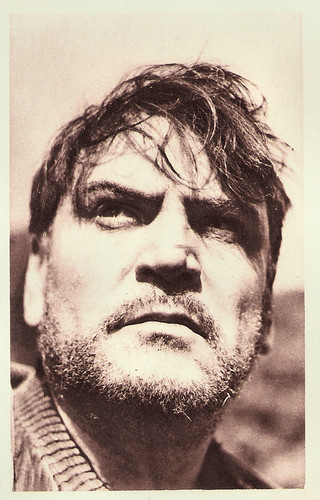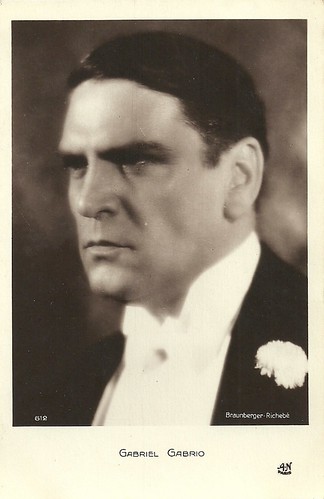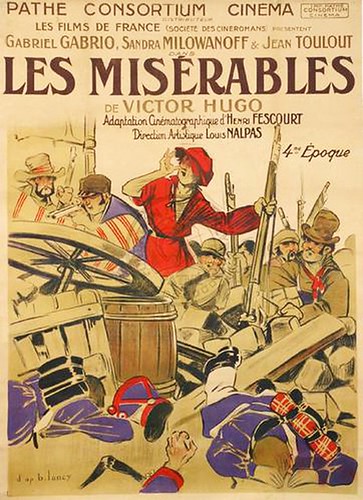A highlight of Le Giornate del Cinema Muto in Pordenone is today's screening of the four-part serial Les Misérables (1925). Jean Valjean is played by Gabriel Gabrio (1887-1946), a tall, burly actor with a boxer's face. He began his cinema career in the silent film era of the 1920s, and is possibly best recalled for his roles as Cesare Borgia in Abel Gance’s Lucrèce Borgia (1935) and as Carlos in the gangster film Pépé le Moko (1937), opposite Jean Gabin.

French postcard by Cinemagazine-Edition, Paris, no. 397.
Dark-haired, blue-eyed Gabriel Gabrio was born Édouard Gabriel Lelièvre in Reims, France, in 1887. He was the youngest of sixteen children. Gabrio's father worked for the Pommeray Champagne cellars.
At the age of seven he developed a keen interest in puppet theatre. As a teen, Gabrio grew to an impressive height of 1 m 83 and after a stint as an apprentice glass window painter, set his sights on a career as a stage actor. He made his first appearance at the Casino of his home town. He also played for five years at the Kursaal.
At the outbreak of World War I, Gabrio enlisted in the French Army and served four years during the hostilities. After being demobilized, Gabrio relocated to Paris where he performed in such theatres as the Gaîté Rochechouart, the Théâtre des Ambassadeurs, the Comédie Montaigne and the Odéon in roles by George Bernard Shaw and William Shakespeare, among others.
Gabrio made his film debut in La fête espagnole/Spanish Fiesta (Germaine Dulac, 1920). In 1924 he was cast by film director Henri Fescourt to appear as Jean Valjean, the literary protagonist in the film adaptation of the Victor Hugo novel Les Misérables whose twenty-year-long struggle with the law for stealing bread during a time of economic and social depression is chronicled.
Gabrio's appearance in the film catapulted him to stardom. In 1927, Gabrio began appearing in international films, such as the German film Der Faschingskönig/Thre King of Carnival (Georg Jacoby, 1927), and in his first and only English language talkie The Inseparables (Adelqui Migliar, John Stafford, 1929) with Elissa Landi. Gabrio attempted to launch a Hollywood career in 1929. Sound, however, made that proposition untenable and he returned to France.

French postcard by Crépa, Editeur, Paris. Photo: Pierre Méré. Publicity still for Regain/Harvest (Marcel Pagnol, 1937) with Gabriel Gabrio as Panturle.

French postcard by A.N., Paris, no. 612. Photo: Braunberger - Richebé.
Gabriel Gabrio's career flourished in France into the 1930s. Memorable are the tough characters he embodied as the grumpy soldier Sulphart in Raymond Bernard's war drama Les Croix de Bois/The wooden crosses (1932). Gabrio then appeared opposite Edwige Feuillère in the historical biopic Lucrèce Borgia/Lucrezia Borgia (Abel Gance, 1935), a box-office hit.
He played Panturle in the drama Regain/Harvest (Marcel Pagnol, 1937) about a farming village where only three inhabitants remain. They are told that if only one of them, Panturle, manages to find a wife, the village will be able to prosper again.
Gabrio is possibly best recalled for his role as Carlos, the gangster cohort of Jean Gabin's character Pépé le Moko in the 1937 film directed by Julien Duvivier. The film would become an international success and was remade in Hollywood as Algiers (1938), starring Charles Boyer, and as a musical, Casbah (1948), starring Tony Martin.
As the 1940s began and Europe was thrust into the World War II, Gabriel Gabrio's film career remained intact in war-torn France. In 1942 he appeared as the executioner, opposite Arletty and Marie Déa in Les Visiteurs du Soir/The Devil's Envoys (Marcel Carné, 1942), penned by Jacques Prévert and Pierre Laroche. The film premiered at Paris’s Madeleine Cinema on 4 December 1942 and was one of the biggest film events during the war. Les Visiteurs du Soir is an allegory of the eternal struggle between good and evil as fourteenth-century lovers defy the Devil. Many people saw the character of the Devil as representing Hitler and the continued beating hearts of the lovers as representing France living under German rule, but not giving up hope. Director Marcel Carné maintained until his death that the film was not an intentional allegory for the war and that any relationship was purely unconscious.
In 1943 Gabriel Gabrio's health declined and he retired into the village of Berchères-sur-Vesgre in the West of France. He died there in 1946 at age 59. The village has since named a street after him in his honour. Guy Bellinger at IMDb: “Gabriel Gabrio is unjustly forgotten and his 'hefty' contribution to the French cinema should be re-appraised.” Maybe the reappraisal start tonight in Pordenone.

Affiche for Les Misérables (1924). Source: Philippe Freyhof@Flickr.
Sources: Guy Bellinger (IMDb), Hans J. Wollstein (AllMovie), Wikipedia and IMDb.

French postcard by Cinemagazine-Edition, Paris, no. 397.
Catapulted to Stardom
Dark-haired, blue-eyed Gabriel Gabrio was born Édouard Gabriel Lelièvre in Reims, France, in 1887. He was the youngest of sixteen children. Gabrio's father worked for the Pommeray Champagne cellars.
At the age of seven he developed a keen interest in puppet theatre. As a teen, Gabrio grew to an impressive height of 1 m 83 and after a stint as an apprentice glass window painter, set his sights on a career as a stage actor. He made his first appearance at the Casino of his home town. He also played for five years at the Kursaal.
At the outbreak of World War I, Gabrio enlisted in the French Army and served four years during the hostilities. After being demobilized, Gabrio relocated to Paris where he performed in such theatres as the Gaîté Rochechouart, the Théâtre des Ambassadeurs, the Comédie Montaigne and the Odéon in roles by George Bernard Shaw and William Shakespeare, among others.
Gabrio made his film debut in La fête espagnole/Spanish Fiesta (Germaine Dulac, 1920). In 1924 he was cast by film director Henri Fescourt to appear as Jean Valjean, the literary protagonist in the film adaptation of the Victor Hugo novel Les Misérables whose twenty-year-long struggle with the law for stealing bread during a time of economic and social depression is chronicled.
Gabrio's appearance in the film catapulted him to stardom. In 1927, Gabrio began appearing in international films, such as the German film Der Faschingskönig/Thre King of Carnival (Georg Jacoby, 1927), and in his first and only English language talkie The Inseparables (Adelqui Migliar, John Stafford, 1929) with Elissa Landi. Gabrio attempted to launch a Hollywood career in 1929. Sound, however, made that proposition untenable and he returned to France.

French postcard by Crépa, Editeur, Paris. Photo: Pierre Méré. Publicity still for Regain/Harvest (Marcel Pagnol, 1937) with Gabriel Gabrio as Panturle.

French postcard by A.N., Paris, no. 612. Photo: Braunberger - Richebé.
Unjustly forgotten
Gabriel Gabrio's career flourished in France into the 1930s. Memorable are the tough characters he embodied as the grumpy soldier Sulphart in Raymond Bernard's war drama Les Croix de Bois/The wooden crosses (1932). Gabrio then appeared opposite Edwige Feuillère in the historical biopic Lucrèce Borgia/Lucrezia Borgia (Abel Gance, 1935), a box-office hit.
He played Panturle in the drama Regain/Harvest (Marcel Pagnol, 1937) about a farming village where only three inhabitants remain. They are told that if only one of them, Panturle, manages to find a wife, the village will be able to prosper again.
Gabrio is possibly best recalled for his role as Carlos, the gangster cohort of Jean Gabin's character Pépé le Moko in the 1937 film directed by Julien Duvivier. The film would become an international success and was remade in Hollywood as Algiers (1938), starring Charles Boyer, and as a musical, Casbah (1948), starring Tony Martin.
As the 1940s began and Europe was thrust into the World War II, Gabriel Gabrio's film career remained intact in war-torn France. In 1942 he appeared as the executioner, opposite Arletty and Marie Déa in Les Visiteurs du Soir/The Devil's Envoys (Marcel Carné, 1942), penned by Jacques Prévert and Pierre Laroche. The film premiered at Paris’s Madeleine Cinema on 4 December 1942 and was one of the biggest film events during the war. Les Visiteurs du Soir is an allegory of the eternal struggle between good and evil as fourteenth-century lovers defy the Devil. Many people saw the character of the Devil as representing Hitler and the continued beating hearts of the lovers as representing France living under German rule, but not giving up hope. Director Marcel Carné maintained until his death that the film was not an intentional allegory for the war and that any relationship was purely unconscious.
In 1943 Gabriel Gabrio's health declined and he retired into the village of Berchères-sur-Vesgre in the West of France. He died there in 1946 at age 59. The village has since named a street after him in his honour. Guy Bellinger at IMDb: “Gabriel Gabrio is unjustly forgotten and his 'hefty' contribution to the French cinema should be re-appraised.” Maybe the reappraisal start tonight in Pordenone.

Affiche for Les Misérables (1924). Source: Philippe Freyhof@Flickr.
Sources: Guy Bellinger (IMDb), Hans J. Wollstein (AllMovie), Wikipedia and IMDb.
No comments:
Post a Comment